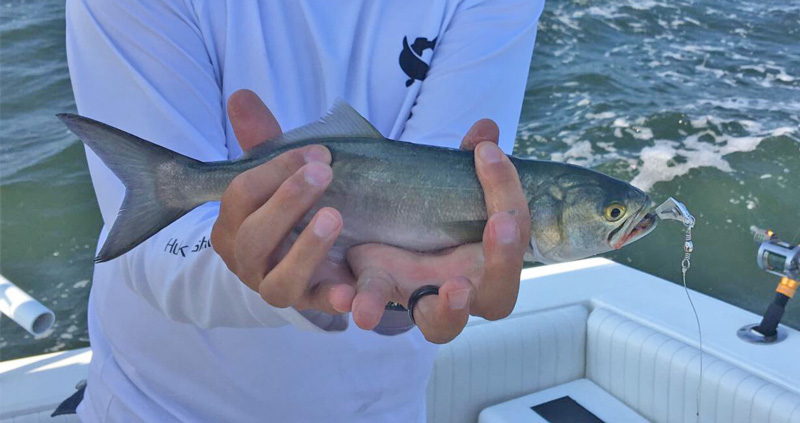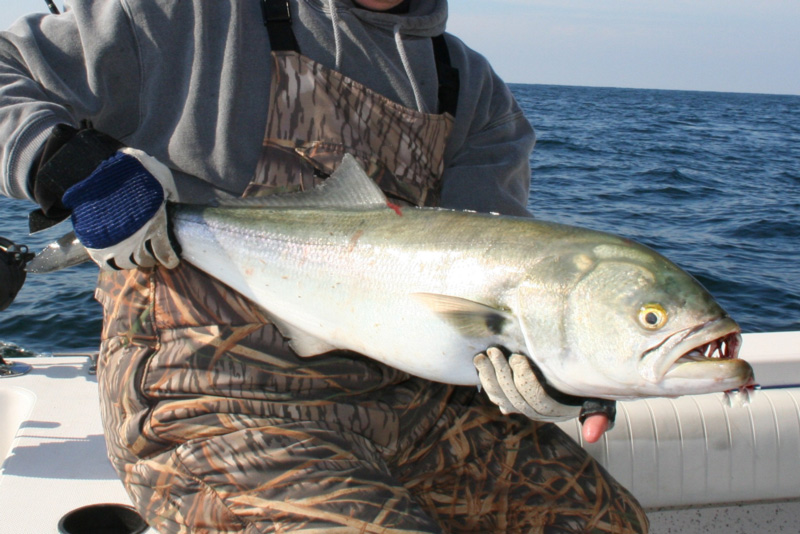Not only do bluefish appear in the Chesapeake Bay and its tributaries, but they can also be found in all of the world’s oceans. Bluefish are most commonly spotted in the Atlantic Ocean and situated along the Gulf of Mexico. These fish are migratory creatures that like to travel to places where it is fairly warm. May through October, however, is prime time on the Chesapeake Bay and along the Mid-Atlantic coast for anglers to catch these incredible fighting fish.

Not only have bluefish become a popular catch among recreational anglers, but they also are caught by commercial fishermen and sold to seafood markets. Bluefish like to travel with like-sized fish and at feeding time, mature bluefish will be seen near the surface attacking schools of bait fish. These fish enjoy hunting for sport, too, where they will kill their prey and not eat them.
Bluefish Identification
Anglers can identify bluefish from the following characteristics:
- Greenish-blue color, silver sides and white underbelly
- Large, blunt head with pointed snout
- Forked tail
- Razor sharp teeth
Members of the Pomatomidae family, some bluefish can grow to 40 inches in length and reach weights upwards of 30 pounds. Bluefish found in the Chesapeake waterways, on the other hand, are rarely anywhere near that large. Still, anglers should take extra precaution when handling these fish regardless of size, due to their impressive biting power and aggression. If one manages to bite you, it will do some damage.
Bluefish Regulations
Here are the size and creel regulations for bluefish:
Record Bluefish
The Maryland Atlantic Division record is currently held by Lillian Morris, reeling in a 23-pound five-ounce fish from Assateague Island in 1974. In Delaware, Luis Mispireta caught a 24-pound 13-ounce bluefish to set the record in 2015. Virginia’s record holder, Gayle Cozzens, tops the rest of these entries; in 1986 she caught a 25-pound four-ounce fish from Bluefish Rock.
Best Baits for Bluefish
Bluefish are not super picky when it comes to choosing their bait, but here are a few great contenders:
- Menhaden
- Mackerel
- Cut fish of any sort
Best Lures for Bluefish
Try out some of these lures when fishing for blues:
- Soft, plastic imitation baits (that are the “bite-proof” variety)
- White bucktail jigs
- Metal spoons
Best Bluefish Fishing Techniques
Atlantic coastal fishermen will often catch bluefish on accident when targeting different fish. Bluefish can be caught using a variety of fishing techniques, with the most popular forms being casting and trolling. The most important thing to keep in mind when fishing for these fish is to use wire leaders and/or a rigid lure they can’t chop through with their sharp teeth.
When trolling anglers often favor metal spoons that are at least four inches long, to prevent bite-offs. Surgical hose eels can also be effective on blues at times, and since most quality versions are rigged with wire securing the hook inside, won’t get bitten off.

Chumming for bluefish with ground menhaden can also be very effective. Once again, the critical factor is to make sure the bluefish can’t bite you hook off. This makes the use of wire leaders a must.
For more information about bluefish fishing techniques, check out our article 5 Tactics to Catch More Bluefish.
Popular Places to Fish for Bluefish
Blues are found throughout the Bay but when setting out on to the next bluefish adventure, keeping in mind the salinity levels and water temperature of places that you frequent. Bodies of water with higher salinities have a higher likelihood of containing bluefish. When salinity drops in areas of the Bay, bluefish are likely to leave and look for saltier waters. In years of very low salinity, blues may be uncommon north of the Bay Bridge.
If you want to catch bigger bluefish, the ocean is the place to try. Very large blues can be caught at inshore lumps and wreck or reef sites, often well above the 10-pound class.

Bluefish will also hit baits cast into the surf, and most seasons large ones can be caught while surf fishing in the spring and fall. Our article bluefish and black drum in the surf is a good read for those wanting to learn more about surf fishing.
Regardless of whether you fish in the Chesapeake Bay or out in the ocean, there’s a good chance that you will encounter a bluefish during your fishing trips this summer – or at least find one that chewed off your line! Bluefish are incredible fighting fish that are sure to offer a fun time to beginners, just make sure to steer clear of their powerful bite when you reel them in. These migratory fish are a joy to catch for anglers in different regions of the United States and the rest of the world.
Learn some more advanced bluefish fishing techniques and see our favorite recipes for cooking bluefish, in Bluefish in the Chesapeake: You, my Yellow-Eyed Girl.
- By Cameron White